University MKT01907 Reflective Report: Tourism and Hospitality Skills
VerifiedAdded on 2022/10/06
|17
|2787
|424
Report
AI Summary
This report presents a student's reflective analysis of their skills and managerial competencies within the context of tourism and hospitality management. The assignment incorporates the Competing Values Framework (CVF) to assess leadership roles across four quadrants: collaborate, create, compete, and control. Part A of the report details the student's self-assessment through CVF surveys, comparing original and subsequent results to identify areas of strength and weakness. It highlights improvements in the control and collaborate quadrants, while noting the need for development in the competing quadrant, particularly concerning innovation. The student reflects on the influence of training, personal focus, and the management team's impact on their skill development. Part B of the report focuses on the importance of understanding the internal environment of tourism and hospitality businesses. It emphasizes the significance of factors like living standards, market positioning, customer satisfaction, and effective management practices to enhance competitiveness. The report also explores the need for flexibility in management, referencing the paradoxical views and complementary models within the industry, as highlighted in the community blog. The report concludes by emphasizing the importance of internal factors and flexibility for modern tourism and hospitality managers.

TOURISM AND HOSPITALITY
Paraphrase This Document
Need a fresh take? Get an instant paraphrase of this document with our AI Paraphraser
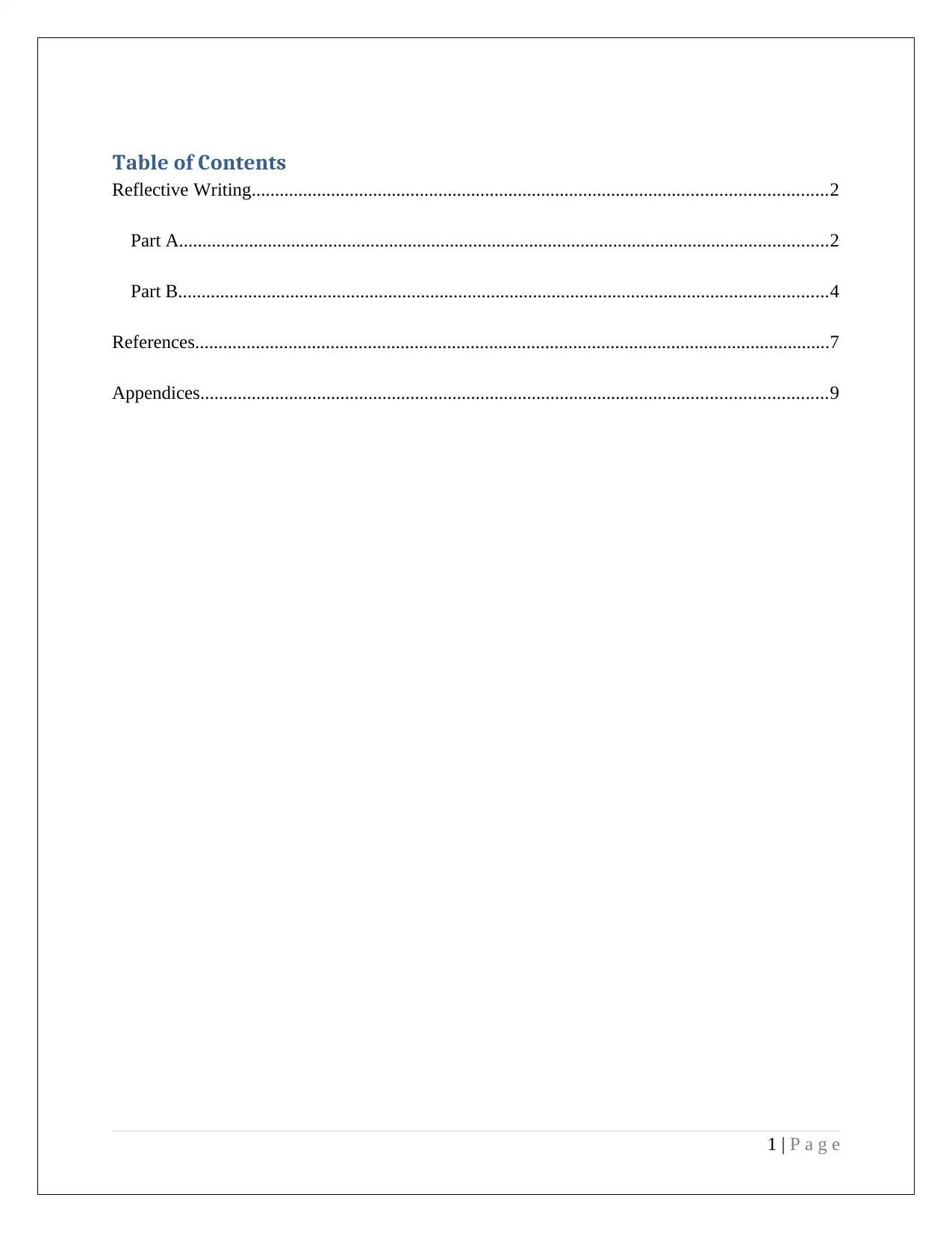
Table of Contents
Reflective Writing...........................................................................................................................2
Part A...........................................................................................................................................2
Part B...........................................................................................................................................4
References........................................................................................................................................7
Appendices......................................................................................................................................9
1 | P a g e
Reflective Writing...........................................................................................................................2
Part A...........................................................................................................................................2
Part B...........................................................................................................................................4
References........................................................................................................................................7
Appendices......................................................................................................................................9
1 | P a g e
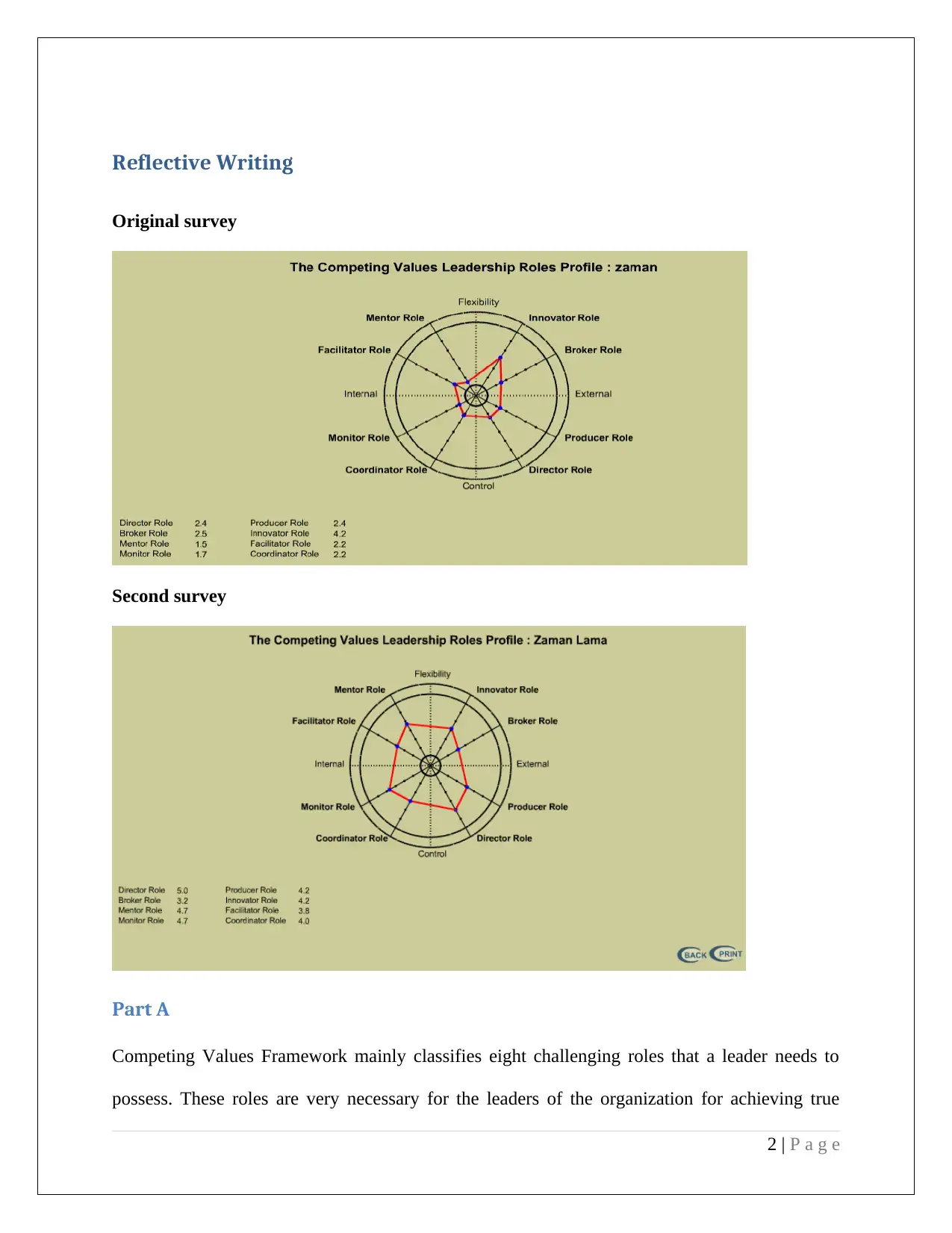
Reflective Writing
Original survey
Second survey
Part A
Competing Values Framework mainly classifies eight challenging roles that a leader needs to
possess. These roles are very necessary for the leaders of the organization for achieving true
2 | P a g e
Original survey
Second survey
Part A
Competing Values Framework mainly classifies eight challenging roles that a leader needs to
possess. These roles are very necessary for the leaders of the organization for achieving true
2 | P a g e
⊘ This is a preview!⊘
Do you want full access?
Subscribe today to unlock all pages.

Trusted by 1+ million students worldwide
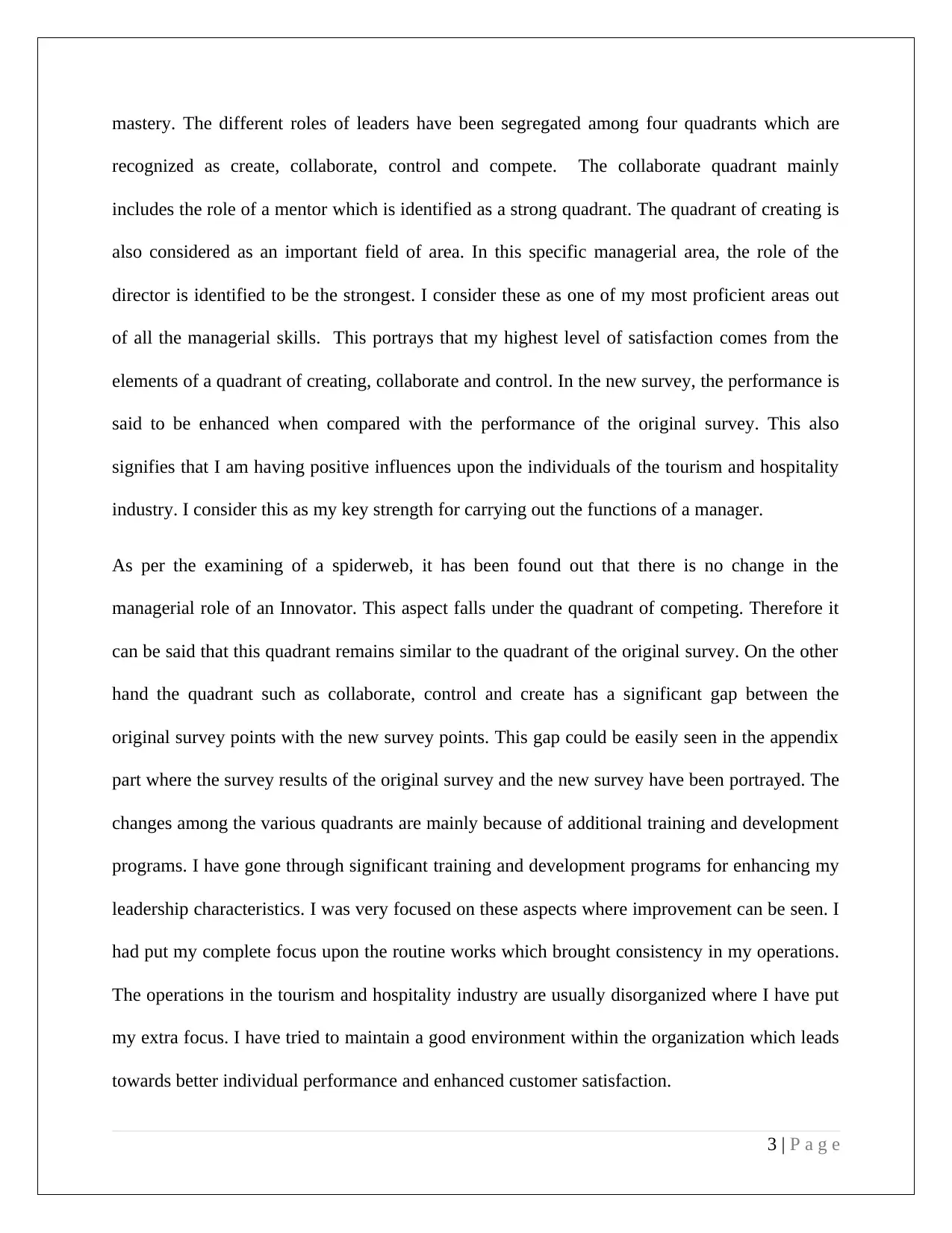
mastery. The different roles of leaders have been segregated among four quadrants which are
recognized as create, collaborate, control and compete. The collaborate quadrant mainly
includes the role of a mentor which is identified as a strong quadrant. The quadrant of creating is
also considered as an important field of area. In this specific managerial area, the role of the
director is identified to be the strongest. I consider these as one of my most proficient areas out
of all the managerial skills. This portrays that my highest level of satisfaction comes from the
elements of a quadrant of creating, collaborate and control. In the new survey, the performance is
said to be enhanced when compared with the performance of the original survey. This also
signifies that I am having positive influences upon the individuals of the tourism and hospitality
industry. I consider this as my key strength for carrying out the functions of a manager.
As per the examining of a spiderweb, it has been found out that there is no change in the
managerial role of an Innovator. This aspect falls under the quadrant of competing. Therefore it
can be said that this quadrant remains similar to the quadrant of the original survey. On the other
hand the quadrant such as collaborate, control and create has a significant gap between the
original survey points with the new survey points. This gap could be easily seen in the appendix
part where the survey results of the original survey and the new survey have been portrayed. The
changes among the various quadrants are mainly because of additional training and development
programs. I have gone through significant training and development programs for enhancing my
leadership characteristics. I was very focused on these aspects where improvement can be seen. I
had put my complete focus upon the routine works which brought consistency in my operations.
The operations in the tourism and hospitality industry are usually disorganized where I have put
my extra focus. I have tried to maintain a good environment within the organization which leads
towards better individual performance and enhanced customer satisfaction.
3 | P a g e
recognized as create, collaborate, control and compete. The collaborate quadrant mainly
includes the role of a mentor which is identified as a strong quadrant. The quadrant of creating is
also considered as an important field of area. In this specific managerial area, the role of the
director is identified to be the strongest. I consider these as one of my most proficient areas out
of all the managerial skills. This portrays that my highest level of satisfaction comes from the
elements of a quadrant of creating, collaborate and control. In the new survey, the performance is
said to be enhanced when compared with the performance of the original survey. This also
signifies that I am having positive influences upon the individuals of the tourism and hospitality
industry. I consider this as my key strength for carrying out the functions of a manager.
As per the examining of a spiderweb, it has been found out that there is no change in the
managerial role of an Innovator. This aspect falls under the quadrant of competing. Therefore it
can be said that this quadrant remains similar to the quadrant of the original survey. On the other
hand the quadrant such as collaborate, control and create has a significant gap between the
original survey points with the new survey points. This gap could be easily seen in the appendix
part where the survey results of the original survey and the new survey have been portrayed. The
changes among the various quadrants are mainly because of additional training and development
programs. I have gone through significant training and development programs for enhancing my
leadership characteristics. I was very focused on these aspects where improvement can be seen. I
had put my complete focus upon the routine works which brought consistency in my operations.
The operations in the tourism and hospitality industry are usually disorganized where I have put
my extra focus. I have tried to maintain a good environment within the organization which leads
towards better individual performance and enhanced customer satisfaction.
3 | P a g e
Paraphrase This Document
Need a fresh take? Get an instant paraphrase of this document with our AI Paraphraser
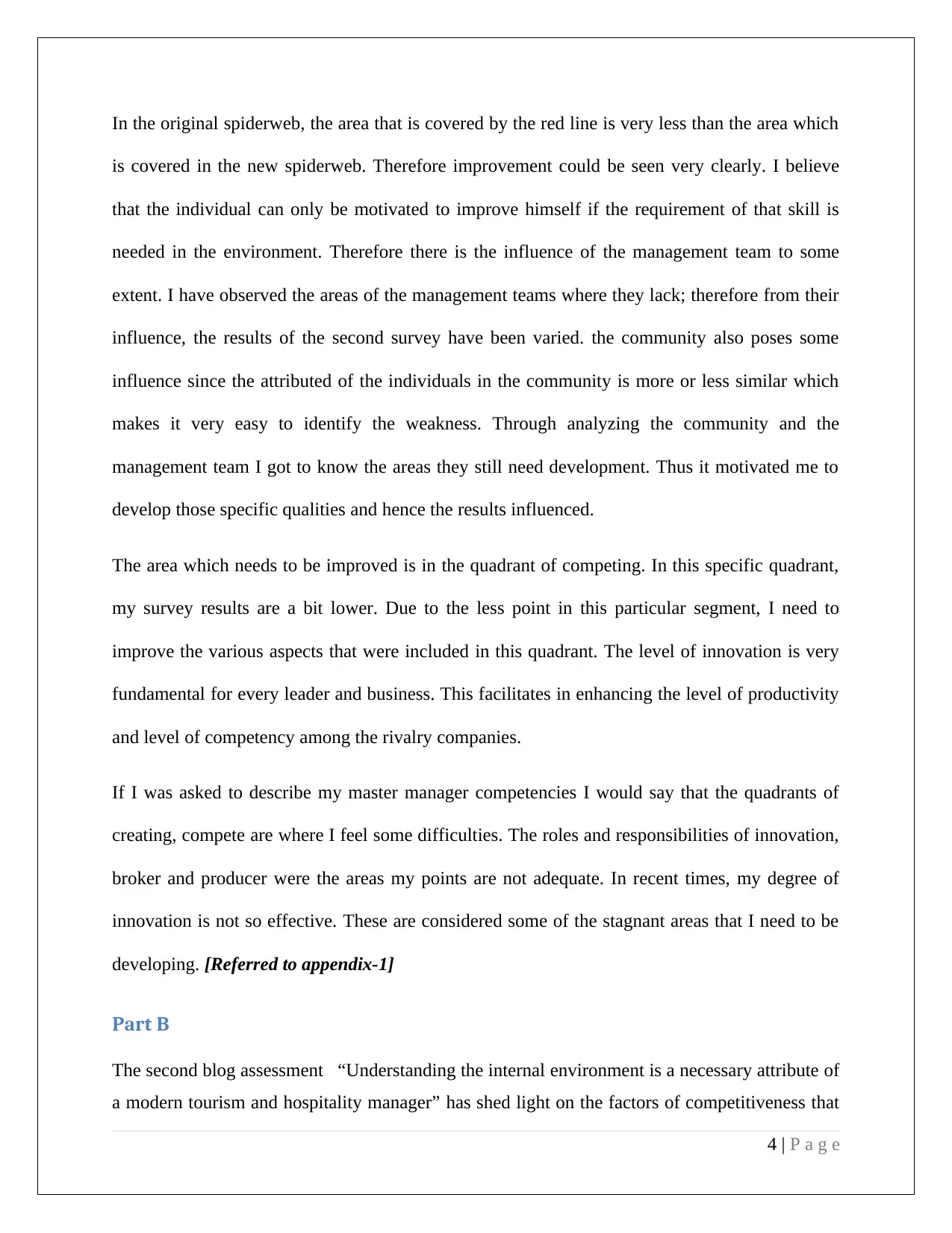
In the original spiderweb, the area that is covered by the red line is very less than the area which
is covered in the new spiderweb. Therefore improvement could be seen very clearly. I believe
that the individual can only be motivated to improve himself if the requirement of that skill is
needed in the environment. Therefore there is the influence of the management team to some
extent. I have observed the areas of the management teams where they lack; therefore from their
influence, the results of the second survey have been varied. the community also poses some
influence since the attributed of the individuals in the community is more or less similar which
makes it very easy to identify the weakness. Through analyzing the community and the
management team I got to know the areas they still need development. Thus it motivated me to
develop those specific qualities and hence the results influenced.
The area which needs to be improved is in the quadrant of competing. In this specific quadrant,
my survey results are a bit lower. Due to the less point in this particular segment, I need to
improve the various aspects that were included in this quadrant. The level of innovation is very
fundamental for every leader and business. This facilitates in enhancing the level of productivity
and level of competency among the rivalry companies.
If I was asked to describe my master manager competencies I would say that the quadrants of
creating, compete are where I feel some difficulties. The roles and responsibilities of innovation,
broker and producer were the areas my points are not adequate. In recent times, my degree of
innovation is not so effective. These are considered some of the stagnant areas that I need to be
developing. [Referred to appendix-1]
Part B
The second blog assessment “Understanding the internal environment is a necessary attribute of
a modern tourism and hospitality manager” has shed light on the factors of competitiveness that
4 | P a g e
is covered in the new spiderweb. Therefore improvement could be seen very clearly. I believe
that the individual can only be motivated to improve himself if the requirement of that skill is
needed in the environment. Therefore there is the influence of the management team to some
extent. I have observed the areas of the management teams where they lack; therefore from their
influence, the results of the second survey have been varied. the community also poses some
influence since the attributed of the individuals in the community is more or less similar which
makes it very easy to identify the weakness. Through analyzing the community and the
management team I got to know the areas they still need development. Thus it motivated me to
develop those specific qualities and hence the results influenced.
The area which needs to be improved is in the quadrant of competing. In this specific quadrant,
my survey results are a bit lower. Due to the less point in this particular segment, I need to
improve the various aspects that were included in this quadrant. The level of innovation is very
fundamental for every leader and business. This facilitates in enhancing the level of productivity
and level of competency among the rivalry companies.
If I was asked to describe my master manager competencies I would say that the quadrants of
creating, compete are where I feel some difficulties. The roles and responsibilities of innovation,
broker and producer were the areas my points are not adequate. In recent times, my degree of
innovation is not so effective. These are considered some of the stagnant areas that I need to be
developing. [Referred to appendix-1]
Part B
The second blog assessment “Understanding the internal environment is a necessary attribute of
a modern tourism and hospitality manager” has shed light on the factors of competitiveness that
4 | P a g e
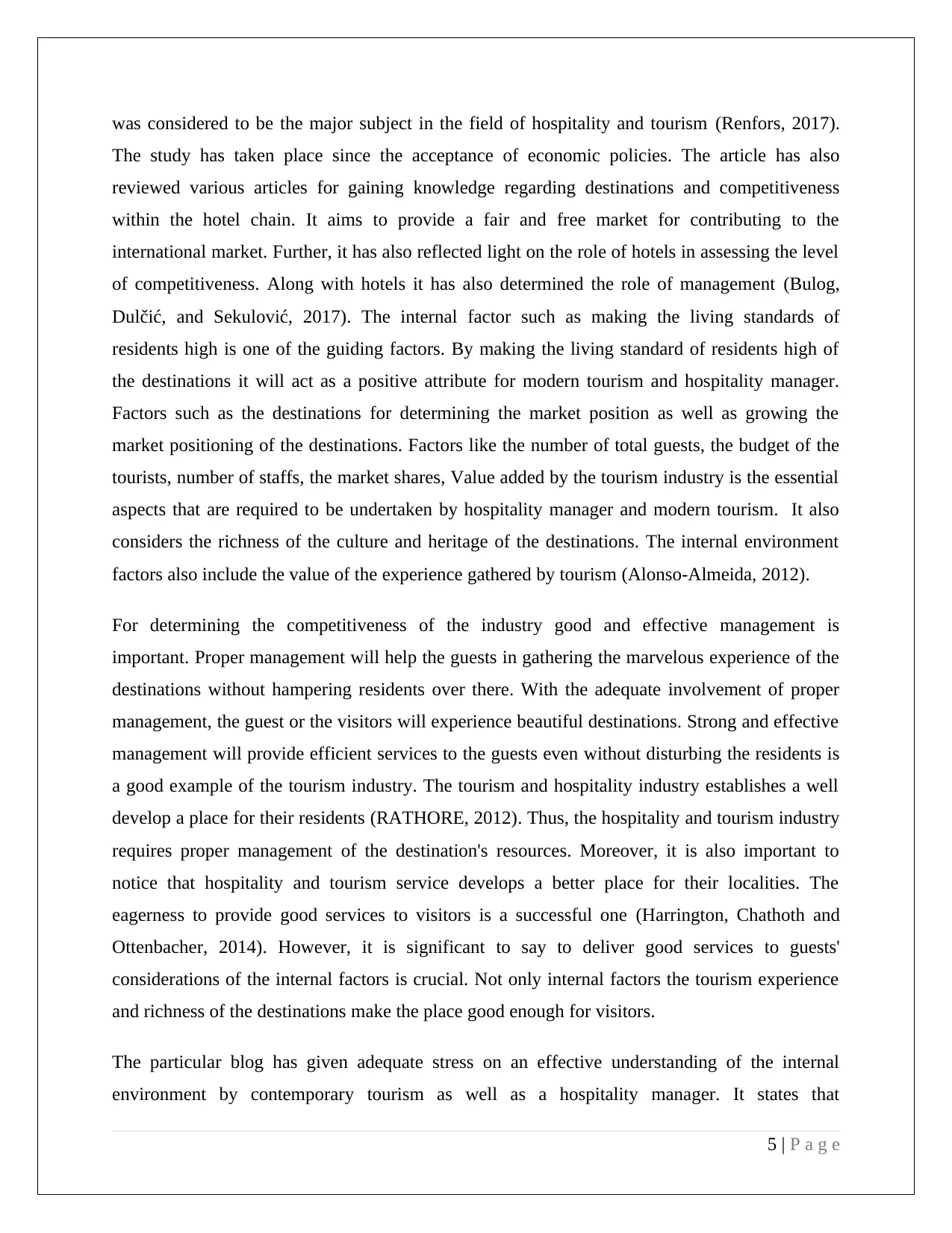
was considered to be the major subject in the field of hospitality and tourism (Renfors, 2017).
The study has taken place since the acceptance of economic policies. The article has also
reviewed various articles for gaining knowledge regarding destinations and competitiveness
within the hotel chain. It aims to provide a fair and free market for contributing to the
international market. Further, it has also reflected light on the role of hotels in assessing the level
of competitiveness. Along with hotels it has also determined the role of management (Bulog,
Dulčić, and Sekulović, 2017). The internal factor such as making the living standards of
residents high is one of the guiding factors. By making the living standard of residents high of
the destinations it will act as a positive attribute for modern tourism and hospitality manager.
Factors such as the destinations for determining the market position as well as growing the
market positioning of the destinations. Factors like the number of total guests, the budget of the
tourists, number of staffs, the market shares, Value added by the tourism industry is the essential
aspects that are required to be undertaken by hospitality manager and modern tourism. It also
considers the richness of the culture and heritage of the destinations. The internal environment
factors also include the value of the experience gathered by tourism (Alonso-Almeida, 2012).
For determining the competitiveness of the industry good and effective management is
important. Proper management will help the guests in gathering the marvelous experience of the
destinations without hampering residents over there. With the adequate involvement of proper
management, the guest or the visitors will experience beautiful destinations. Strong and effective
management will provide efficient services to the guests even without disturbing the residents is
a good example of the tourism industry. The tourism and hospitality industry establishes a well
develop a place for their residents (RATHORE, 2012). Thus, the hospitality and tourism industry
requires proper management of the destination's resources. Moreover, it is also important to
notice that hospitality and tourism service develops a better place for their localities. The
eagerness to provide good services to visitors is a successful one (Harrington, Chathoth and
Ottenbacher, 2014). However, it is significant to say to deliver good services to guests'
considerations of the internal factors is crucial. Not only internal factors the tourism experience
and richness of the destinations make the place good enough for visitors.
The particular blog has given adequate stress on an effective understanding of the internal
environment by contemporary tourism as well as a hospitality manager. It states that
5 | P a g e
The study has taken place since the acceptance of economic policies. The article has also
reviewed various articles for gaining knowledge regarding destinations and competitiveness
within the hotel chain. It aims to provide a fair and free market for contributing to the
international market. Further, it has also reflected light on the role of hotels in assessing the level
of competitiveness. Along with hotels it has also determined the role of management (Bulog,
Dulčić, and Sekulović, 2017). The internal factor such as making the living standards of
residents high is one of the guiding factors. By making the living standard of residents high of
the destinations it will act as a positive attribute for modern tourism and hospitality manager.
Factors such as the destinations for determining the market position as well as growing the
market positioning of the destinations. Factors like the number of total guests, the budget of the
tourists, number of staffs, the market shares, Value added by the tourism industry is the essential
aspects that are required to be undertaken by hospitality manager and modern tourism. It also
considers the richness of the culture and heritage of the destinations. The internal environment
factors also include the value of the experience gathered by tourism (Alonso-Almeida, 2012).
For determining the competitiveness of the industry good and effective management is
important. Proper management will help the guests in gathering the marvelous experience of the
destinations without hampering residents over there. With the adequate involvement of proper
management, the guest or the visitors will experience beautiful destinations. Strong and effective
management will provide efficient services to the guests even without disturbing the residents is
a good example of the tourism industry. The tourism and hospitality industry establishes a well
develop a place for their residents (RATHORE, 2012). Thus, the hospitality and tourism industry
requires proper management of the destination's resources. Moreover, it is also important to
notice that hospitality and tourism service develops a better place for their localities. The
eagerness to provide good services to visitors is a successful one (Harrington, Chathoth and
Ottenbacher, 2014). However, it is significant to say to deliver good services to guests'
considerations of the internal factors is crucial. Not only internal factors the tourism experience
and richness of the destinations make the place good enough for visitors.
The particular blog has given adequate stress on an effective understanding of the internal
environment by contemporary tourism as well as a hospitality manager. It states that
5 | P a g e
⊘ This is a preview!⊘
Do you want full access?
Subscribe today to unlock all pages.

Trusted by 1+ million students worldwide
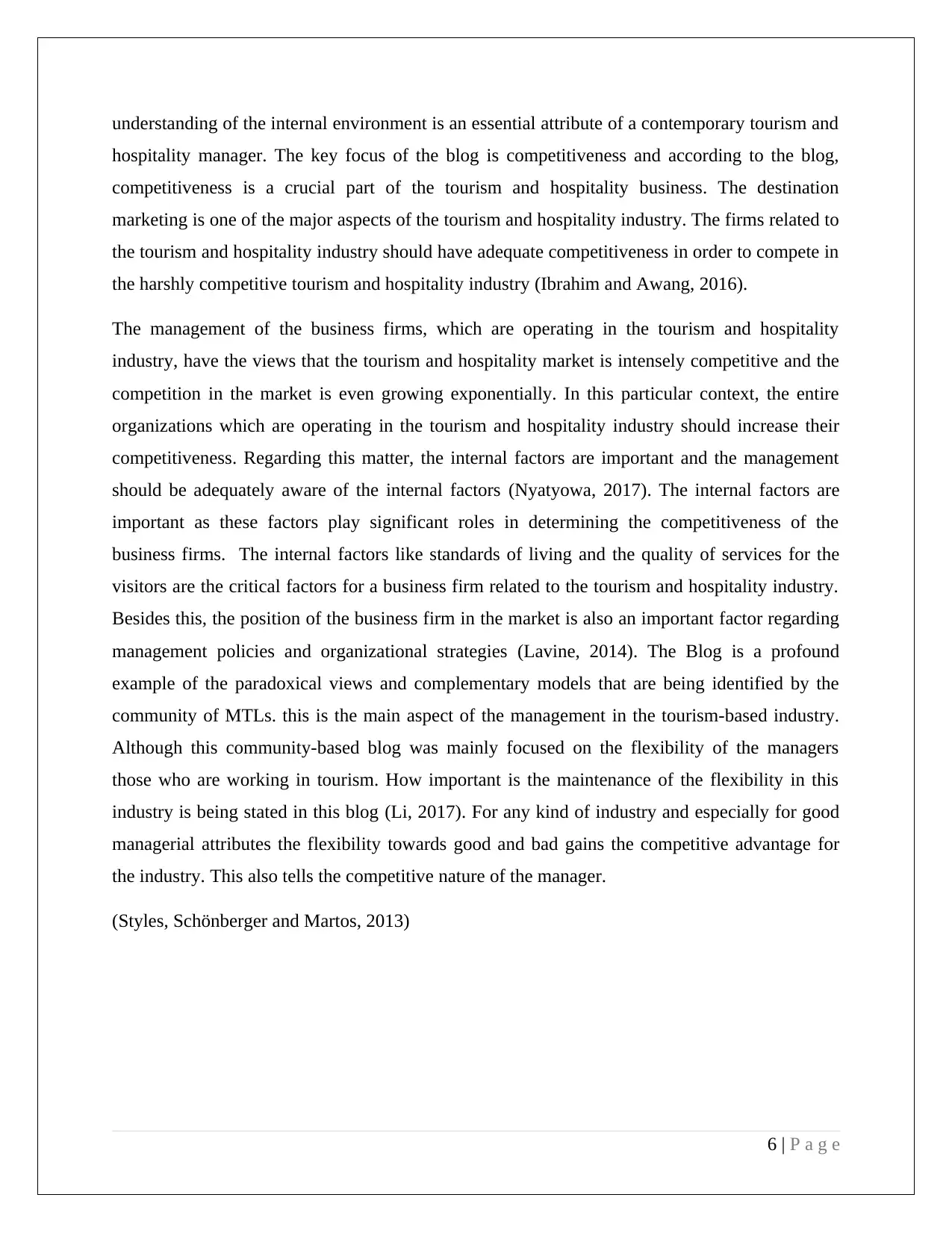
understanding of the internal environment is an essential attribute of a contemporary tourism and
hospitality manager. The key focus of the blog is competitiveness and according to the blog,
competitiveness is a crucial part of the tourism and hospitality business. The destination
marketing is one of the major aspects of the tourism and hospitality industry. The firms related to
the tourism and hospitality industry should have adequate competitiveness in order to compete in
the harshly competitive tourism and hospitality industry (Ibrahim and Awang, 2016).
The management of the business firms, which are operating in the tourism and hospitality
industry, have the views that the tourism and hospitality market is intensely competitive and the
competition in the market is even growing exponentially. In this particular context, the entire
organizations which are operating in the tourism and hospitality industry should increase their
competitiveness. Regarding this matter, the internal factors are important and the management
should be adequately aware of the internal factors (Nyatyowa, 2017). The internal factors are
important as these factors play significant roles in determining the competitiveness of the
business firms. The internal factors like standards of living and the quality of services for the
visitors are the critical factors for a business firm related to the tourism and hospitality industry.
Besides this, the position of the business firm in the market is also an important factor regarding
management policies and organizational strategies (Lavine, 2014). The Blog is a profound
example of the paradoxical views and complementary models that are being identified by the
community of MTLs. this is the main aspect of the management in the tourism-based industry.
Although this community-based blog was mainly focused on the flexibility of the managers
those who are working in tourism. How important is the maintenance of the flexibility in this
industry is being stated in this blog (Li, 2017). For any kind of industry and especially for good
managerial attributes the flexibility towards good and bad gains the competitive advantage for
the industry. This also tells the competitive nature of the manager.
(Styles, Schönberger and Martos, 2013)
6 | P a g e
hospitality manager. The key focus of the blog is competitiveness and according to the blog,
competitiveness is a crucial part of the tourism and hospitality business. The destination
marketing is one of the major aspects of the tourism and hospitality industry. The firms related to
the tourism and hospitality industry should have adequate competitiveness in order to compete in
the harshly competitive tourism and hospitality industry (Ibrahim and Awang, 2016).
The management of the business firms, which are operating in the tourism and hospitality
industry, have the views that the tourism and hospitality market is intensely competitive and the
competition in the market is even growing exponentially. In this particular context, the entire
organizations which are operating in the tourism and hospitality industry should increase their
competitiveness. Regarding this matter, the internal factors are important and the management
should be adequately aware of the internal factors (Nyatyowa, 2017). The internal factors are
important as these factors play significant roles in determining the competitiveness of the
business firms. The internal factors like standards of living and the quality of services for the
visitors are the critical factors for a business firm related to the tourism and hospitality industry.
Besides this, the position of the business firm in the market is also an important factor regarding
management policies and organizational strategies (Lavine, 2014). The Blog is a profound
example of the paradoxical views and complementary models that are being identified by the
community of MTLs. this is the main aspect of the management in the tourism-based industry.
Although this community-based blog was mainly focused on the flexibility of the managers
those who are working in tourism. How important is the maintenance of the flexibility in this
industry is being stated in this blog (Li, 2017). For any kind of industry and especially for good
managerial attributes the flexibility towards good and bad gains the competitive advantage for
the industry. This also tells the competitive nature of the manager.
(Styles, Schönberger and Martos, 2013)
6 | P a g e
Paraphrase This Document
Need a fresh take? Get an instant paraphrase of this document with our AI Paraphraser
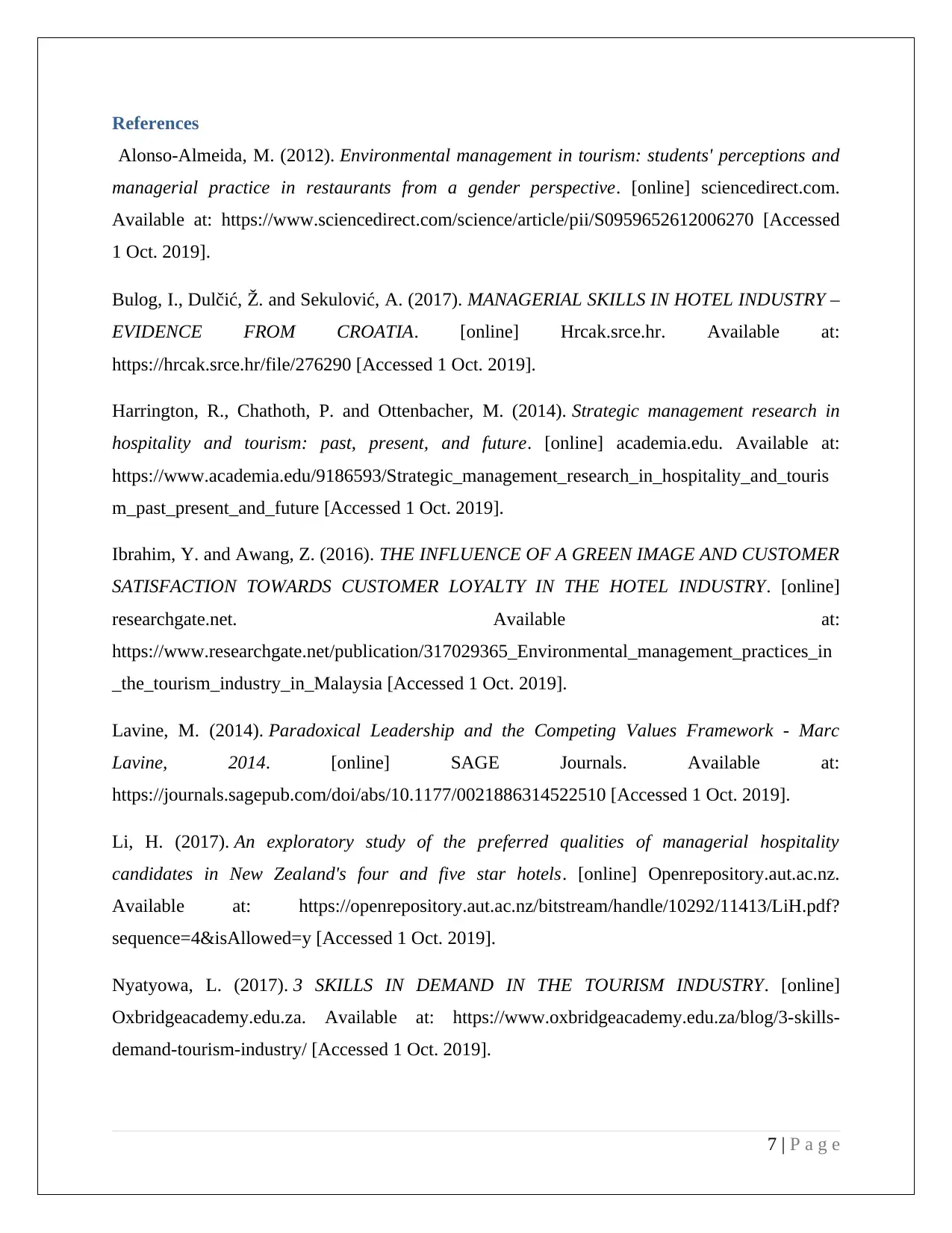
References
Alonso-Almeida, M. (2012). Environmental management in tourism: students' perceptions and
managerial practice in restaurants from a gender perspective. [online] sciencedirect.com.
Available at: https://www.sciencedirect.com/science/article/pii/S0959652612006270 [Accessed
1 Oct. 2019].
Bulog, I., Dulčić, Ž. and Sekulović, A. (2017). MANAGERIAL SKILLS IN HOTEL INDUSTRY –
EVIDENCE FROM CROATIA. [online] Hrcak.srce.hr. Available at:
https://hrcak.srce.hr/file/276290 [Accessed 1 Oct. 2019].
Harrington, R., Chathoth, P. and Ottenbacher, M. (2014). Strategic management research in
hospitality and tourism: past, present, and future. [online] academia.edu. Available at:
https://www.academia.edu/9186593/Strategic_management_research_in_hospitality_and_touris
m_past_present_and_future [Accessed 1 Oct. 2019].
Ibrahim, Y. and Awang, Z. (2016). THE INFLUENCE OF A GREEN IMAGE AND CUSTOMER
SATISFACTION TOWARDS CUSTOMER LOYALTY IN THE HOTEL INDUSTRY. [online]
researchgate.net. Available at:
https://www.researchgate.net/publication/317029365_Environmental_management_practices_in
_the_tourism_industry_in_Malaysia [Accessed 1 Oct. 2019].
Lavine, M. (2014). Paradoxical Leadership and the Competing Values Framework - Marc
Lavine, 2014. [online] SAGE Journals. Available at:
https://journals.sagepub.com/doi/abs/10.1177/0021886314522510 [Accessed 1 Oct. 2019].
Li, H. (2017). An exploratory study of the preferred qualities of managerial hospitality
candidates in New Zealand's four and five star hotels. [online] Openrepository.aut.ac.nz.
Available at: https://openrepository.aut.ac.nz/bitstream/handle/10292/11413/LiH.pdf?
sequence=4&isAllowed=y [Accessed 1 Oct. 2019].
Nyatyowa, L. (2017). 3 SKILLS IN DEMAND IN THE TOURISM INDUSTRY. [online]
Oxbridgeacademy.edu.za. Available at: https://www.oxbridgeacademy.edu.za/blog/3-skills-
demand-tourism-industry/ [Accessed 1 Oct. 2019].
7 | P a g e
Alonso-Almeida, M. (2012). Environmental management in tourism: students' perceptions and
managerial practice in restaurants from a gender perspective. [online] sciencedirect.com.
Available at: https://www.sciencedirect.com/science/article/pii/S0959652612006270 [Accessed
1 Oct. 2019].
Bulog, I., Dulčić, Ž. and Sekulović, A. (2017). MANAGERIAL SKILLS IN HOTEL INDUSTRY –
EVIDENCE FROM CROATIA. [online] Hrcak.srce.hr. Available at:
https://hrcak.srce.hr/file/276290 [Accessed 1 Oct. 2019].
Harrington, R., Chathoth, P. and Ottenbacher, M. (2014). Strategic management research in
hospitality and tourism: past, present, and future. [online] academia.edu. Available at:
https://www.academia.edu/9186593/Strategic_management_research_in_hospitality_and_touris
m_past_present_and_future [Accessed 1 Oct. 2019].
Ibrahim, Y. and Awang, Z. (2016). THE INFLUENCE OF A GREEN IMAGE AND CUSTOMER
SATISFACTION TOWARDS CUSTOMER LOYALTY IN THE HOTEL INDUSTRY. [online]
researchgate.net. Available at:
https://www.researchgate.net/publication/317029365_Environmental_management_practices_in
_the_tourism_industry_in_Malaysia [Accessed 1 Oct. 2019].
Lavine, M. (2014). Paradoxical Leadership and the Competing Values Framework - Marc
Lavine, 2014. [online] SAGE Journals. Available at:
https://journals.sagepub.com/doi/abs/10.1177/0021886314522510 [Accessed 1 Oct. 2019].
Li, H. (2017). An exploratory study of the preferred qualities of managerial hospitality
candidates in New Zealand's four and five star hotels. [online] Openrepository.aut.ac.nz.
Available at: https://openrepository.aut.ac.nz/bitstream/handle/10292/11413/LiH.pdf?
sequence=4&isAllowed=y [Accessed 1 Oct. 2019].
Nyatyowa, L. (2017). 3 SKILLS IN DEMAND IN THE TOURISM INDUSTRY. [online]
Oxbridgeacademy.edu.za. Available at: https://www.oxbridgeacademy.edu.za/blog/3-skills-
demand-tourism-industry/ [Accessed 1 Oct. 2019].
7 | P a g e

RATHORE, N. (2012). A STUDY ON MAPPING OF HUMAN RESOURCE SKILL GAPS IN
TOURISM INDUSTRY. [online] Indianresearchjournals.com. Available at:
http://indianresearchjournals.com/pdf/IJMFSMR/2012/February/ijm-5.pdf [Accessed 1 Oct.
2019].
Renfors, S. (2017). Skills Needed in International Tourism Business Development. [online]
Pdfs.semanticscholar.org. Available at:
https://pdfs.semanticscholar.org/10ec/ba53194378a3f9ef9333a4f0f9b8c9f79fe5.pdf [Accessed 1
Oct. 2019].
Styles, D., Schönberger, H. and Martos, J. (2013). Best Environmental Management Practice in
the Tourism Sector. [online] Susproc.jrc.ec.europa.eu. Available at:
https://susproc.jrc.ec.europa.eu/activities/emas/documents/TourismBEMP.pdf [Accessed 1 Oct.
2019].
8 | P a g e
TOURISM INDUSTRY. [online] Indianresearchjournals.com. Available at:
http://indianresearchjournals.com/pdf/IJMFSMR/2012/February/ijm-5.pdf [Accessed 1 Oct.
2019].
Renfors, S. (2017). Skills Needed in International Tourism Business Development. [online]
Pdfs.semanticscholar.org. Available at:
https://pdfs.semanticscholar.org/10ec/ba53194378a3f9ef9333a4f0f9b8c9f79fe5.pdf [Accessed 1
Oct. 2019].
Styles, D., Schönberger, H. and Martos, J. (2013). Best Environmental Management Practice in
the Tourism Sector. [online] Susproc.jrc.ec.europa.eu. Available at:
https://susproc.jrc.ec.europa.eu/activities/emas/documents/TourismBEMP.pdf [Accessed 1 Oct.
2019].
8 | P a g e
⊘ This is a preview!⊘
Do you want full access?
Subscribe today to unlock all pages.

Trusted by 1+ million students worldwide

Appendices
Appendix-1
Comparison report
The Facilitator
Questions Original survey Points New survey points
9 3 3
12 1 3
14 2 4
21 2 5
30 3 4
Total: 2.2 3.8
The Mentor
Original survey
Questions Original survey Points New survey
points
10 1 4
16 2 5
18 2 5
32 1 5
9 | P a g e
Appendix-1
Comparison report
The Facilitator
Questions Original survey Points New survey points
9 3 3
12 1 3
14 2 4
21 2 5
30 3 4
Total: 2.2 3.8
The Mentor
Original survey
Questions Original survey Points New survey
points
10 1 4
16 2 5
18 2 5
32 1 5
9 | P a g e
Paraphrase This Document
Need a fresh take? Get an instant paraphrase of this document with our AI Paraphraser
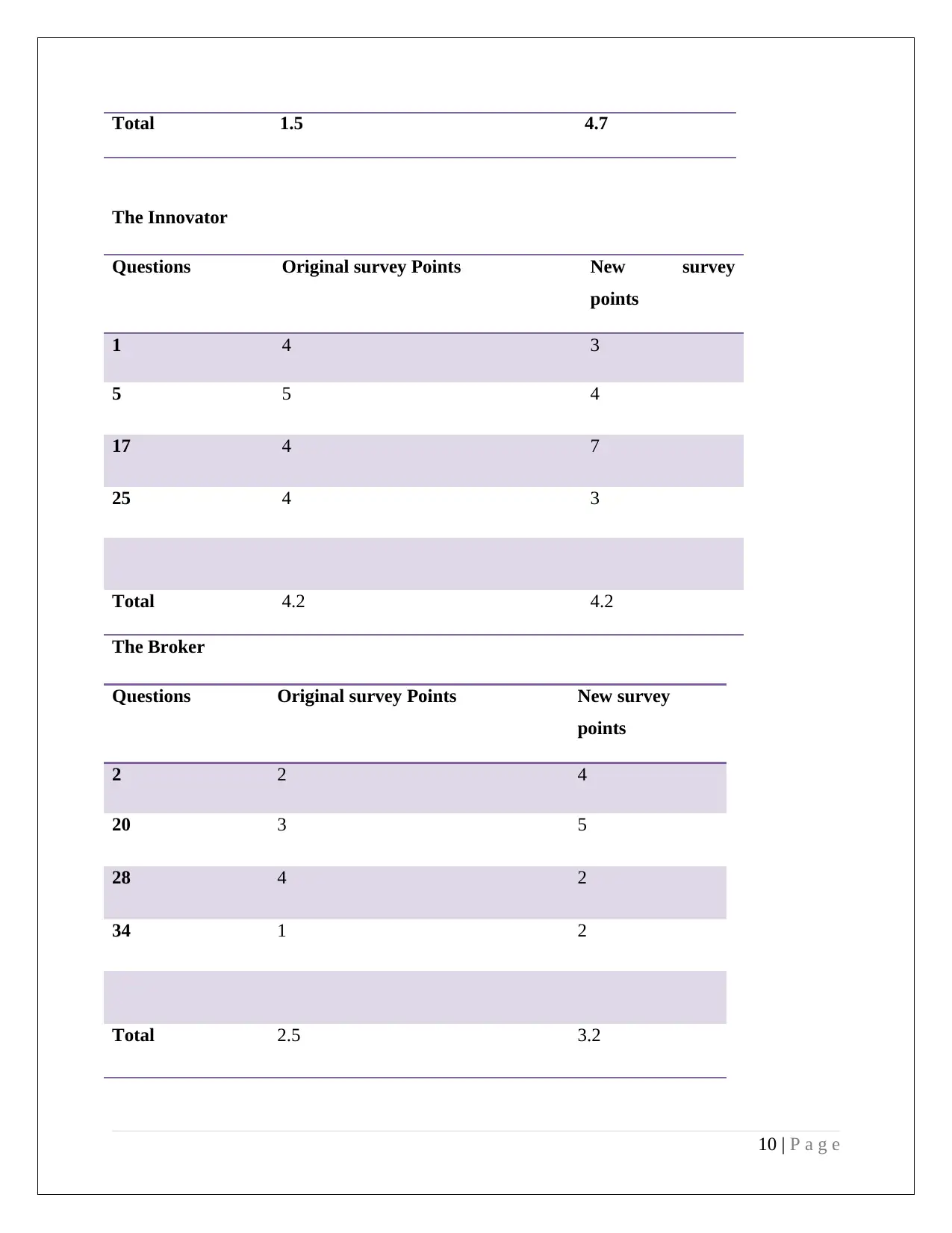
Total 1.5 4.7
The Innovator
Questions Original survey Points New survey
points
1 4 3
5 5 4
17 4 7
25 4 3
Total 4.2 4.2
The Broker
Questions Original survey Points New survey
points
2 2 4
20 3 5
28 4 2
34 1 2
Total 2.5 3.2
10 | P a g e
The Innovator
Questions Original survey Points New survey
points
1 4 3
5 5 4
17 4 7
25 4 3
Total 4.2 4.2
The Broker
Questions Original survey Points New survey
points
2 2 4
20 3 5
28 4 2
34 1 2
Total 2.5 3.2
10 | P a g e

The Producer
Questions number Original survey Points New survey
points
3 3 6
13 4 5
19 2 3
29 2 3
33 1 4
Total 2.4 4.2
The Director
Questions number Original survey Points New survey
points
4 3 5
6 2 4
24 3 5
31 2 7
35 3 4
Total 2.6 5.0
11 | P a g e
Questions number Original survey Points New survey
points
3 3 6
13 4 5
19 2 3
29 2 3
33 1 4
Total 2.4 4.2
The Director
Questions number Original survey Points New survey
points
4 3 5
6 2 4
24 3 5
31 2 7
35 3 4
Total 2.6 5.0
11 | P a g e
⊘ This is a preview!⊘
Do you want full access?
Subscribe today to unlock all pages.

Trusted by 1+ million students worldwide
1 out of 17
Related Documents
Your All-in-One AI-Powered Toolkit for Academic Success.
+13062052269
info@desklib.com
Available 24*7 on WhatsApp / Email
![[object Object]](/_next/static/media/star-bottom.7253800d.svg)
Unlock your academic potential
Copyright © 2020–2025 A2Z Services. All Rights Reserved. Developed and managed by ZUCOL.





